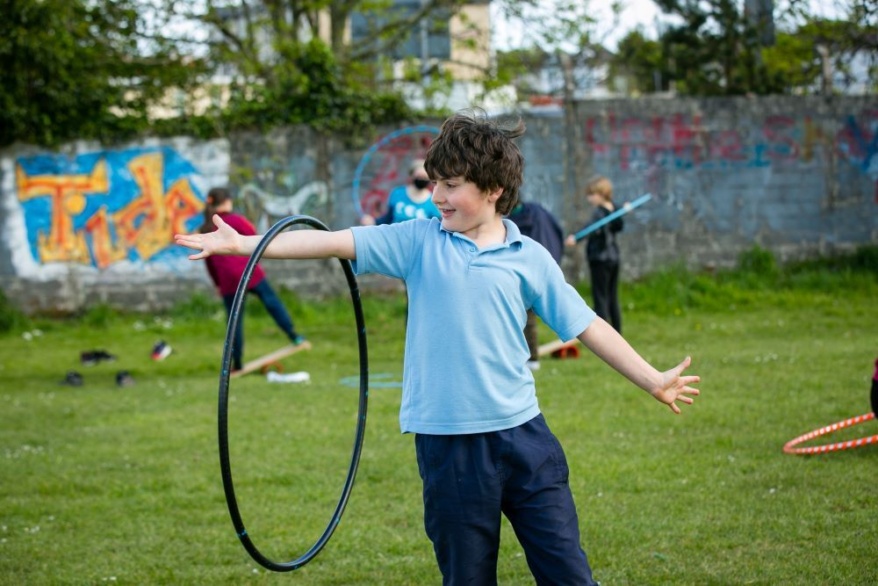“Circus saved my life”: the unseen impact of circus arts on children’s wellbeing
By Sophie Gunther
When you think of circus, what do you think about? Clowns, juggling, and acrobatics? Entertaining shows, where trapeze artists fly effortlessly through the air? Yes, circus includes all the above – yet, for the artists, children and young people it is much more.
In fact, research has shown that engaging with non-competitive, leisure-based circus arts provides multiple benefits for children and young people. These benefits range from increased self-confidence to physical benefits such as better body awareness and coordination, improved fitness, up to cognitive advantages, namely improved decision-making and critical thinking.
Juliette O’Donnell: How circus arts changed her life
On this Tuesday afternoon, children between the age of 8 to 11 years, full of energy, run around between the bright, colourfully painted walls of the Circus Hall. Juliette O’Donnell, Galway Community Circus tutor and a trapeze artist herself, knew about the circus from an early age through her friends. She had also watched their shows, yet she was “far too insecure” to join. “I thought that people who did aerial were gods on earth and that it was inhumanely amazing and that I am not good enough for that, and I will never be worthy enough to try that.”
The 22-year-old speaks confidently, even when talking about her own mental health issues. “I had a lot of mental health difficulties at that time, so my mom called the circus without asking me. She told me ‘On Wednesday you are going to the circus’”. Her first time at the circus was also her first time on a trapeze. “The first second I got on it I had this complete indescribable feeling”, she recalls. “Everything changed. I realized that I could be worth something, that my body could do things that I was proud of, that I could have a reason to take care of myself. That I had something to give to others, something to share with others, that could give and receive love, and that I could create art. I always say that I never got off that trapeze.”
The transformative benefits of circus arts for children
To start the class, the children are asked to represent their feelings through creatively manipulating objects such as hoops or balls. Then, Juliette announces today’s program.
The special focus of today’s class lays on partner acrobatics. When asked by their tutors to recall the most important aspects of partner acrobatics, multiple hands shoot up: “Don’t panic”, “balance”, “trust” and “teamwork”. Indeed, circus provides many social benefits. The skills learned by the artists foster their sense of trust and collaboration instead of competition, and their sense of belonging. Additionally, there is the learning of safe risk-taking, “which reduces a lot of risk factors for adolescence”, says Juliette.
During the class, the children are encouraged to try new things and to believe in themselves, but without forcing them to cross their self-set boundaries. “Every single time young people come into the circus they are either one step closer to or they do achieve something that they were not able to do before and something that they thought they wouldn’t be able to do. That changes a lot of things in your brain.”
The emphasis lays on congratulating the children for their achievements, regardless how small they may seem at first glance. The words “good job!” or “well done!” are pronounced countless times, and for a good reason. “A lot of young people don’t get told that people are proud of them, and trust me, when they come into my class, they get told that. I never know what kind of experience my students had before then, but I know that I have them for an hour and a half. And in that hour and a half I want them to feel like there is an adult who trusts them and who believes in them”.
Beyond increasing self-confidence and self-esteem, there is another major benefit that comes with circus training: “Resilience, resilience, resilience. You drop the ball, you pick it back up again, a million times”. There is also the concept of self-efficacy which is of great importance. “Self-efficacy is your own perception of what your abilities are, your confidence in your own abilities, which makes you a thousand times more likely to try”, Juliette explains.
At the end of the class, the children are asked again how they are feeling. This time, they answer through speaking their emotions: “good”, “tired”, “exhausted”, - and “proud”.
“Every single one of these things I have seen measurably change in my students. I have seen it change their life”. Believing that circus is for and benefits all people, Galway Community Circus pays great attention to inclusivity and diversity, trying to adapt to individual needs. The Circus welcomes everyone, regardless of one’s ethnicity, gender identity, social circumstances, sexual orientation, language, religion, or disabilities. Galway Community Circus provides a safe space where every member is treated respectfully, is valued, and experiences a sense of belonging.
Looking towards the future
“Circus saved my life”, Juliette says. “It gave me everything that I have, and now I get to give it to other people which is kind of insanely the best thing ever”. When asked about her thoughts and hopes for the future of Galway Community Circus, her answer is clear: “One of the goals of Galway Community Circus is to have circus be accessible to every child in Ireland. The benefits of it are endless, so if everybody could have access to it that would be absolutely amazing.”



